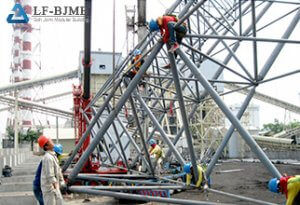+86 177 5193 6871
222, Block B, Diamond International, Guozhuang Road, Xuzhou, Jiangsu, China
The support of the space frame generally has peripheral support, point support, etc. Peripheral support is the most commonly used form of support, it is the space frame peripheral nodes on the column or beam; Point support means that the space frame is placed on an independent column, and the column is not connected with other structures.
The space frame structure generally adopts the winding support mode. When the lower chord support is used due to the requirements of building functions, vertical or inclined side trusses should be formed around the supporting edges of the space frame to ensure that the geometry of the space frame is not deformed, and the vertical and horizontal loads of the upper chord can be effectively transmitted to the support.
In order to ensure the stability of each truss outside the plane and the effective transmission and distribution of horizontal loads such as wind load on the roof structure, closed horizontal supports should be set on the space frame around the upper chord. For large-span structures or when the lower chord is supported around the space frame, closed horizontal supports should be set along the lower chord around the space frame.
For the multi-point support space frame, because the support column is too few, the internal force of the column surrounding the member is generally very large. The column cap can be set on the top of the column to reduce the support span of the space frame, and disperse the internal force of the rod around the support column, and the nodes are also difficult to deal with, so the column cap should be set on the top of the column for multi-point support space frame.
The column cap should be set under the lower chord plane, and can also be set above the upper chord plane or use umbrella shaped column cap. The form of column cap can be combined with the requirements of building functions (such as ventilation, lighting, etc.) to adopt different forms.
The support structure of the reticulated shell, including its support nodes and edge members, is very important to the correct force of the reticulated shell. If the required edge constraint conditions can not be met, the mesh shell can not be achieved to bear the stress characteristics of the film, sometimes the bending internal force will be greatly increased, so that the internal force of the mesh shell member changes, and even the internal force is reversed. The supporting structure of the reticulated shell should not only reliably transmit the vertical reaction force but also meet the edge constraints required by different reticulated shell structural forms. The edge restraint members should meet the stiffness requirements and be carried out together with the reticle shell structure overall calculation.

The corresponding bearing constraints of each type of mesh shell shall comply with the following provisions:
1.The supporting point of spherical mesh shell should ensure the constraint condition of resisting horizontal displacement;
2.When the cylindrical mesh shell is supported along the two longitudinal edges, the support point should ensure the constraints of lateral horizontal displacement resistance;
3.The hyperbolic parabolic mesh shell should transfer the load to the lower structure through the edge members;
4.The mesh shell and four combined parabolic mesh shells are supported along the periphery through the edge members.
